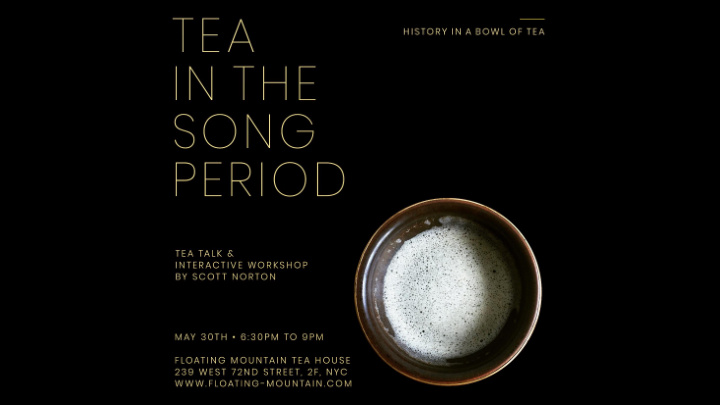



TEA IN THE SONG PERIOD • History of the Song • Tea Development in the Song Period • Teaware of the Song Period • Art and Tea in the Song Period • Grinding Song Period-Style 抹茶 Mǒchá
Song dynasty ( 宋朝 ; Sòng cháo ) 960 – 1279 Southern Song, 1127 – 1279 Song dynasty circa 1100
Famous Teas and Tea-Producing Regions Ancient-style Cake Tea Tang Tea Gardens During the Song Period 960 – 1279 Hēi chá Lóng Fèng Tuán Chá Gǔzhushān * Proto- Wūlóngchá Bāshān * 古株山 Song Period Báichá 巴山 Proto-Báichá Qīngchéng s hān * Ānjí báichá 青城山 安吉白茶 Méngdǐngshān * Wùyuán gòngchá 蒙頂山 婺源貢茶 Yǎ'ān * 雅安 Wǔyíshān * 武夷山 Éméishān * 峨眉山 Fúdǐng báichá** 福鼎白茶 Bǎoshān * 保山 Zhènghé báichá** Líncāng * 政和白茶 臨滄 Pǔ'ěr * Běiyuàn lóng tuán chá 普洱 北苑龍團茶 Xīshuāngbǎnnà * 西雙版納 Yǒngchūn * Ānxī * Ancient Tea Horse Road 永春 * Region 安溪 Liù bǎo chá ** Anachronistic Attribution 六堡茶 Fènghuáng shān fèng tuán chá 鳳凰山鳳團茶
Contemporary produced Korean 떡차 ddok cha, “compressed cake tea”.
Contemporary produced basket-wrapped 六安黑茶 Liù ān hēi chá, “Liu An Black Tea”
Images of various Song dynasty Longfeng Tuancha molds from the Sì Kù Quán S hū 四庫全書 ( Complete Library of the Four Treasuries ), 1772. Various Song dynasty period Longfeng Tuancha 龍鳳團茶 (“ Dragon Phoenix tea cakes”)
Modern-day reproduction of Longfeng Tuancha 龍鳳團茶 (“Dragon Phoenix tea cake”)
Famous Teaware-Producing Kilns of the Song Period 960 – 1279 Rǔ yáo 汝窯 Cízhōu yáo 磁州窯 Yuè( zhōu ) yáo 越 ( 州 ) 窯 Jūn yáo 鈞窯 Guān yáo 官窯 Yàozhōu yáo 耀州窯 Jiàn yáo 建窯 Jízhōu yáo 吉州窯 Lóngquán qīngcí 龍泉青瓷
Images of wares for the preparation of making tea from the 茶具圖贊 Chájù tú zàn ( Pictorial of Tea ) by Shenan, 1269.
Ding ware white glaze ceramic tea grinder , 9 th to10 th Century, late Tang (618-907) to early Northern Song Dynasty (960-1127).
The Painting of “ Literary Gathering ” by Zhao Ji, Northern Song Dynasty (618 -907) Handscroll, ink and colors on silk, 184.4 x 123.9 cm, National Palace Museum, Taipei.
Qingbai ewer, bowls, and pumpkin-shaped lobed container, Late Song to Early Yuan dynasties (1100s-1200s)
An incised Yue ewer and cover, Northern Song dynasty (960-1127)
Jian 'hare's fur' tea bowl, Southern Song dynasty (1127-1279)
Assorted 吉州窯 Jízhōu yáo teabowls. Note floral pattern resist motif, loose brush stroke and “tortoise shell” patternation. Late southern Song dynasty (c. 1200 – 1279).
吉州窯 Jízhōu yáo teabowl with natural leaf resist decoration. Late southern Song dynasty (c. 1200 – 1279).
Luohans Drinking Tea , Zhou Jichang (active late-12th century), Southern Song Dynasty, from the Daitokuji denrai Gohyakurakanzu (The Daitokuji 500 Luohan Paintings). Published by Nara National Museum and National Research Institute for Cultural Properties, Tokyo, 2014.
Luohans Drinking Tea , Zhou Jichang (active late-12th century), Southern Song Dynasty, from the Daitokuji denrai Gohyakurakanzu (The Daitokuji 500 Luohan Paintings). Published by Nara National Museum and National Research Institute for Cultural Properties, Tokyo, 2014.
“ Youdi ” black glaze tea bowl on red lacquer receptacle, Southern Song Dynasty ( 127 ~ 1279 A.D. ), Collection at Museum of Oriental Ceramics, Osaka.
“Tea Extraction/Grinding” by Liu Song Nian 劉松年 (about 1155-1218), Southern Song Dynasty (1127-1279) Handscroll, ink and colors on silk
“Tea Extraction/Grinding” by Liu Song Nian 劉松年 (about 1155-1218), Southern Song Dynasty (1127-1279) Handscroll, ink and colors on silk
Tea Competition 鬥茶圖 ( detail ), Liu Song Nian 劉松年 , c.1200, Collection the National Palace Museum, Taipei.
“Tea is of light colour and looks best in black cups. The cups made at Jianyang are bluish-black in colour, marked like the fur of a hare. Being of rather thick fabric they retain the heat, so that when once warmed through they cool very slowly, and they are additionally valued on this account. None of the cups produced at other places can rival these .” Cai Xiang 茶录 , The Record of Tea (c.1049-1053)
Grinding Song Period-Style 抹茶 Mǒchá 3. Remove twigs 1. Start with loose leaves 2. Begin softly grinding tea leaves
6. Continue grinding 4. Sift-out larger particles 5. Continue grinding (note tea “hairs”)
9. Tea is ready for whisking 7. Continue grinding (note, lighter, softer texture) 8. Intermittently sift between grinding, extracting tea “hairs”
Recommend
More recommend